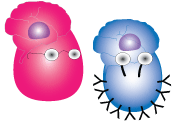
Somatic hypermutation
Antibodies are produced and secreted by plasma cells, which is the final state that an activated B cell can become. The plasma cell's cytoplasm is filled with rough endoplasmic reticulum and it is here that the antibodies are produced. Antibodies are another word for immunoglobulins composed of heavy (H) and light (L) chains. In all previous B cell stages, Igs have been stuck in the plasma membrane, but plasma cells have now got the ability to remove the "sticky section" from the Ig allowing it to be released from the cell into body fluids.
Activated mature B cells with IgM and IgD on the surface become plasma cells both outside and inside B cell follicles. The plasma cells outside the B cell follicle, produce most of the Ig released during a primary immune response. These antibodies are of the IgM isotype and some IgG isotype, just like the surface bound Ig, and they tend to bind to their epitope with varying degrees of tightness. For a quick, strong and efficient immune response against a pathogen it is important to have antibodies with strong binding affinity for the pathogenic antigen. B cells have therefore got a process in place to increase the binding of their antibodies, called somatic hypermutation. See if you can figure out how somatic hypermutation works in this video.

As B cells divide, their entire genome is replicated so that each daughter cell gets a complete copy of the entire DNA. However, mistakes made in the Ig genes during DNA replication are intentionally not fixed and this is part of the process called somatic hypermutation. Think about how changes in the DNA sequence of the Ig variable region would affect the shape the antigen binding site. Can you therefore guess what happens to the affinity of the antibody after somatic hypermutation? It might become stronger or it might become weaker. The binding strength of these newly shaped Igs are then tested on antigens presented by local follicular dendritic cells, and only high strength binding saves the life of the B cell.